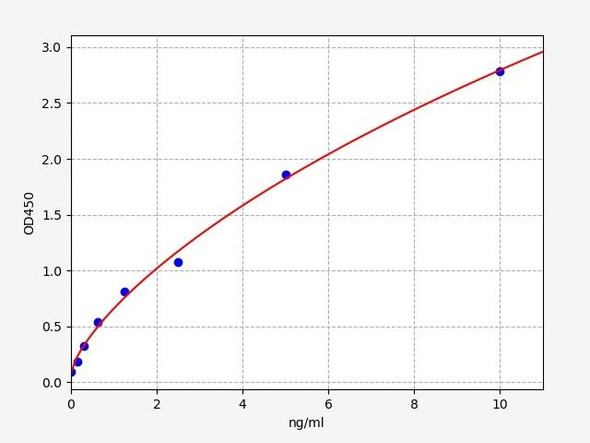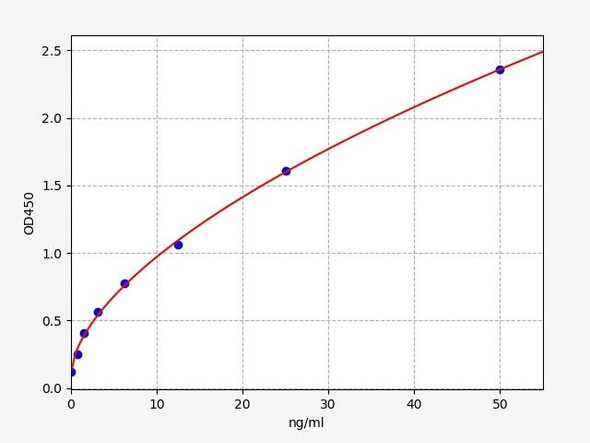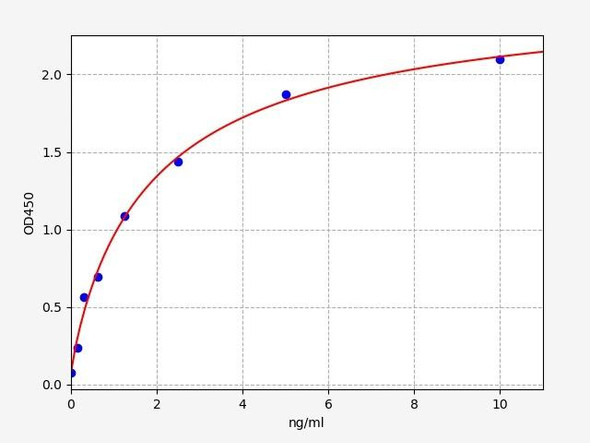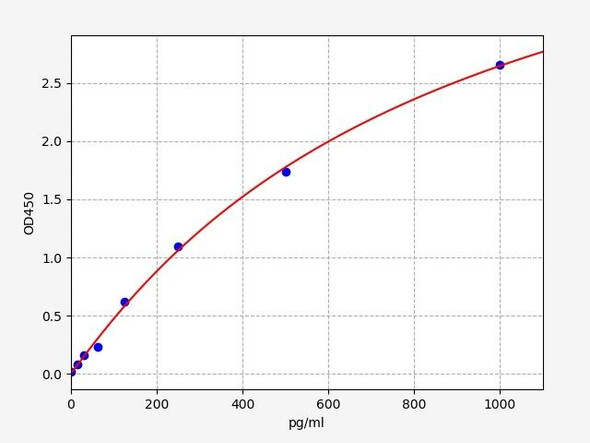Human CEBP alpha ELISA Kit
- SKU:
- HUFI02265
- Product Type:
- ELISA Kit
- Size:
- 96 Assays
- Uniprot:
- P49715
- Sensitivity:
- 0.188ng/ml
- Range:
- 0.313-20ng/ml
- ELISA Type:
- Sandwich
- Synonyms:
- C, EBPalpha
- Reactivity:
- Human
Description
Human CEBP alpha ELISA Kit
The Human CEBP-Alpha ELISA Kit is specifically designed for the precise measurement of CCAAT/enhancer binding protein alpha levels in human biological samples such as serum, plasma, and cell culture supernatants. This advanced kit offers unparalleled sensitivity and specificity, ensuring accurate and reproducible results for a variety of research applications.CEBP-Alpha is a key transcription factor involved in the regulation of various genes associated with cell differentiation, immune response, and metabolism.
Dysregulation of CEBP-Alpha has been linked to several diseases including cancer, diabetes, and inflammatory disorders, highlighting its importance as a biomarker for studying these conditions and potential therapeutic interventions.Trust the Human CEBP-Alpha ELISA Kit to deliver precise and reliable data for your research needs, allowing for a deeper understanding of the role of CEBP-Alpha in health and disease.
| Product Name: | Human CEBP alpha ELISA Kit |
| Product Code: | HUFI02265 |
| Size: | 96 Assays |
| Alias: | C, EBPalpha |
| Detection method: | Sandwich ELISA, Double Antibody |
| Application: | This immunoassay kit allows for the in vitro quantitative determination of Human C/EBPalpha concentrations in serum plasma and other biological fluids. |
| Sensitivity: | 0.188ng/ml |
| Range: | 0.313-20ng/ml |
| Storage: | 4°C for 6 months |
| Note: | For Research Use Only |
| Recovery: | Matrices listed below were spiked with certain level of Human C/EBPalpha and the recovery rates were calculated by comparing the measured value to the expected amount of Human C/EBPalpha in samples. | ||||||||||||||||
| |||||||||||||||||
| Linearity: | The linearity of the kit was assayed by testing samples spiked with appropriate concentration of Human C/EBPalpha and their serial dilutions. The results were demonstrated by the percentage of calculated concentration to the expected. | ||||||||||||||||
| |||||||||||||||||
| CV(%): | Intra-Assay: CV<8% Inter-Assay: CV<10% |
| Component | Quantity | Storage |
| ELISA Microplate (Dismountable) | 8×12 strips | 4°C for 6 months |
| Lyophilized Standard | 2 | 4°C/-20°C |
| Sample/Standard Dilution Buffer | 20ml | 4°C |
| Biotin-labeled Antibody(Concentrated) | 120ul | 4°C (Protect from light) |
| Antibody Dilution Buffer | 10ml | 4°C |
| HRP-Streptavidin Conjugate(SABC) | 120ul | 4°C (Protect from light) |
| SABC Dilution Buffer | 10ml | 4°C |
| TMB Substrate | 10ml | 4°C (Protect from light) |
| Stop Solution | 10ml | 4°C |
| Wash Buffer(25X) | 30ml | 4°C |
| Plate Sealer | 5 | - |
Other materials and equipment required:
- Microplate reader with 450 nm wavelength filter
- Multichannel Pipette, Pipette, microcentrifuge tubes and disposable pipette tips
- Incubator
- Deionized or distilled water
- Absorbent paper
- Buffer resevoir
| Uniprot | P49715 |
| UniProt Protein Function: | C/EBP-alpha: a bZIP transcription factor which can form homodimers or heterodimers with the related proteins CEBP-beta and CEBP-gamma. Binds to the promoter and modulate the expression of the gene encoding leptin, a protein that plays an important role in body weight homeostasis. Can interact with CDK2 and CDK4, thereby inhibiting these kinases and causing growth arrest in cultured cells. |
| UniProt Protein Details: | Protein type:DNA-binding; Transcription factor Chromosomal Location of Human Ortholog: 19q13.1 Cellular Component: Rb-E2F complex; nuclear matrix; nucleus Molecular Function:RNA polymerase II transcription factor activity, enhancer binding; protein binding; protein homodimerization activity; DNA binding; protein heterodimerization activity; protein complex binding; transcription factor activity; transcription factor binding Biological Process: transcription from RNA polymerase II promoter; fat cell differentiation; embryonic placenta development; macrophage differentiation; viral reproduction; cell maturation; response to glucocorticoid stimulus; negative regulation of transcription from RNA polymerase II promoter; glucose homeostasis; negative regulation of cell proliferation; response to vitamin B2; acute-phase response; inner ear development; cholesterol metabolic process; mitochondrion organization and biogenesis; generation of precursor metabolites and energy; organ regeneration; granulocyte differentiation; transcription, DNA-dependent; cytokine and chemokine mediated signaling pathway; negative regulation of cyclin-dependent protein kinase activity; liver development; positive regulation of osteoblast differentiation; positive regulation of proteasomal ubiquitin-dependent protein catabolic process; white fat cell differentiation; brown fat cell differentiation; positive regulation of fat cell differentiation; positive regulation of transcription from RNA polymerase III promoter; myeloid cell differentiation; positive regulation of transcription from RNA polymerase II promoter; urea cycle; lung development Disease: Leukemia, Acute Myeloid |
| NCBI Summary: | This intronless gene encodes a transcription factor that contains a basic leucine zipper (bZIP) domain and recognizes the CCAAT motif in the promoters of target genes. The encoded protein functions in homodimers and also heterodimers with CCAAT/enhancer-binding proteins beta and gamma. Activity of this protein can modulate the expression of genes involved in cell cycle regulation as well as in body weight homeostasis. Mutation of this gene is associated with acute myeloid leukemia. The use of alternative in-frame non-AUG (GUG) and AUG start codons results in protein isoforms with different lengths. Differential translation initiation is mediated by an out-of-frame, upstream open reading frame which is located between the GUG and the first AUG start codons. [provided by RefSeq, Dec 2013] |
| UniProt Code: | P49715 |
| NCBI GenInfo Identifier: | 166898082 |
| NCBI Gene ID: | 1050 |
| NCBI Accession: | P49715.3 |
| UniProt Secondary Accession: | P49715,P78319, Q05CA4, A7LNP2, |
| UniProt Related Accession: | P49715 |
| Molecular Weight: | 37,561 Da |
| NCBI Full Name: | CCAAT/enhancer-binding protein alpha |
| NCBI Synonym Full Names: | CCAAT/enhancer binding protein (C/EBP), alpha |
| NCBI Official Symbol: | CEBPA |
| NCBI Official Synonym Symbols: | CEBP; C/EBP-alpha |
| NCBI Protein Information: | CCAAT/enhancer-binding protein alpha |
| UniProt Protein Name: | CCAAT/enhancer-binding protein alpha |
| Protein Family: | CCAAT/enhancer-binding protein |
| UniProt Gene Name: | CEBPA |
| UniProt Entry Name: | CEBPA_HUMAN |
*Note: Protocols are specific to each batch/lot. For the correct instructions please follow the protocol included in your kit.
Before adding to wells, equilibrate the SABC working solution and TMB substrate for at least 30 min at 37°C. When diluting samples and reagents, they must be mixed completely and evenly. It is recommended to plot a standard curve for each test.
| Step | Protocol |
| 1. | Set standard, test sample and control (zero) wells on the pre-coated plate respectively, and then, record their positions. It is recommended to measure each standard and sample in duplicate. Wash plate 2 times before adding standard, sample and control (zero) wells! |
| 2. | Aliquot 0.1ml standard solutions into the standard wells. |
| 3. | Add 0.1 ml of Sample / Standard dilution buffer into the control (zero) well. |
| 4. | Add 0.1 ml of properly diluted sample ( Human serum, plasma, tissue homogenates and other biological fluids.) into test sample wells. |
| 5. | Seal the plate with a cover and incubate at 37 °C for 90 min. |
| 6. | Remove the cover and discard the plate content, clap the plate on the absorbent filter papers or other absorbent material. Do NOT let the wells completely dry at any time. Wash plate X2. |
| 7. | Add 0.1 ml of Biotin- detection antibody working solution into the above wells (standard, test sample & zero wells). Add the solution at the bottom of each well without touching the side wall. |
| 8. | Seal the plate with a cover and incubate at 37°C for 60 min. |
| 9. | Remove the cover, and wash plate 3 times with Wash buffer. Let wash buffer rest in wells for 1 min between each wash. |
| 10. | Add 0.1 ml of SABC working solution into each well, cover the plate and incubate at 37°C for 30 min. |
| 11. | Remove the cover and wash plate 5 times with Wash buffer, and each time let the wash buffer stay in the wells for 1-2 min. |
| 12. | Add 90 µl of TMB substrate into each well, cover the plate and incubate at 37°C in dark within 10-20 min. (Note: This incubation time is for reference use only, the optimal time should be determined by end user.) And the shades of blue can be seen in the first 3-4 wells (with most concentrated standard solutions), the other wells show no obvious color. |
| 13. | Add 50 µl of Stop solution into each well and mix thoroughly. The color changes into yellow immediately. |
| 14. | Read the O.D. absorbance at 450 nm in a microplate reader immediately after adding the stop solution. |
When carrying out an ELISA assay it is important to prepare your samples in order to achieve the best possible results. Below we have a list of procedures for the preparation of samples for different sample types.
| Sample Type | Protocol |
| Serum | If using serum separator tubes, allow samples to clot for 30 minutes at room temperature. Centrifuge for 10 minutes at 1,000x g. Collect the serum fraction and assay promptly or aliquot and store the samples at -80°C. Avoid multiple freeze-thaw cycles. If serum separator tubes are not being used, allow samples to clot overnight at 2-8°C. Centrifuge for 10 minutes at 1,000x g. Remove serum and assay promptly or aliquot and store the samples at -80°C. Avoid multiple freeze-thaw cycles. |
| Plasma | Collect plasma using EDTA or heparin as an anticoagulant. Centrifuge samples at 4°C for 15 mins at 1000 × g within 30 mins of collection. Collect the plasma fraction and assay promptly or aliquot and store the samples at -80°C. Avoid multiple freeze-thaw cycles. Note: Over haemolysed samples are not suitable for use with this kit. |
| Urine & Cerebrospinal Fluid | Collect the urine (mid-stream) in a sterile container, centrifuge for 20 mins at 2000-3000 rpm. Remove supernatant and assay immediately. If any precipitation is detected, repeat the centrifugation step. A similar protocol can be used for cerebrospinal fluid. |
| Cell culture supernatant | Collect the cell culture media by pipette, followed by centrifugation at 4°C for 20 mins at 1500 rpm. Collect the clear supernatant and assay immediately. |
| Cell lysates | Solubilize cells in lysis buffer and allow to sit on ice for 30 minutes. Centrifuge tubes at 14,000 x g for 5 minutes to remove insoluble material. Aliquot the supernatant into a new tube and discard the remaining whole cell extract. Quantify total protein concentration using a total protein assay. Assay immediately or aliquot and store at ≤ -20 °C. |
| Tissue homogenates | The preparation of tissue homogenates will vary depending upon tissue type. Rinse tissue with 1X PBS to remove excess blood & homogenize in 20ml of 1X PBS (including protease inhibitors) and store overnight at ≤ -20°C. Two freeze-thaw cycles are required to break the cell membranes. To further disrupt the cell membranes you can sonicate the samples. Centrifuge homogenates for 5 mins at 5000xg. Remove the supernatant and assay immediately or aliquot and store at -20°C or -80°C. |
| Tissue lysates | Rinse tissue with PBS, cut into 1-2 mm pieces, and homogenize with a tissue homogenizer in PBS. Add an equal volume of RIPA buffer containing protease inhibitors and lyse tissues at room temperature for 30 minutes with gentle agitation. Centrifuge to remove debris. Quantify total protein concentration using a total protein assay. Assay immediately or aliquot and store at ≤ -20 °C. |
| Breast Milk | Collect milk samples and centrifuge at 10,000 x g for 60 min at 4°C. Aliquot the supernatant and assay. For long term use, store samples at -80°C. Minimize freeze/thaw cycles. |








